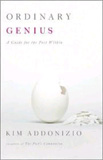Review by Sandee Lyles
ORDINARY GENIUS
by Kim Addonizio
W. W. NORTON & COMPANY, INC.
500 Fifth Avenue
New York, N.Y. 10110
ISBN 978-0-393-33416-6
2009, 288 pp., $16.95
www.wwnorton.com
“Art is therapeutic. It helps you to take something that is within you and make a place for it outside of yourself,” Kim Addonizio declares. Co-author of National Book Award finalist The Poet’s Companion, Addonizio creates a place to find inspiration and tips on birthing a masterful poem in her latest endeavor.
Ordinary Genius: A Guide for the Poet Within is an exceptional book for poets who have lost their muse or potential poets who just need a jump start. Addonizio brings a fresh approach and endless pages of prompts to spark and ignite even the most stubborn writer’s block. She exhibits examples from classic as well as contemporary poets and then teaches how to build, from the examples, one’s own poem. She shares insights from the masters such as Plath, Camus, and Ginsberg, to name a few. She rebukes Ginsberg’s claim about first thoughts being best and proclaims that sometimes “first thoughts are the worst thoughts.” She re-qualifies his statement later by stating, “It’s about letting go of the conditioned mind–all of those received thoughts–and tuning in to some level of thinking that’s deeper than our usual concerns.”
In addition to her countless ideas regarding getting started, the book is also a crash course in how to become a more publishable poet. She is encouraging as she explains that if one wants to become a poet and feels they aren’t very good at it, if they will just keep with it, read, and practice, they will inevitably get better and better. She uses examples of her own personal experiences to bring her point home. She mentions her successes as well as her failures, or, as she likes to refer to them, her genius and her demons. It is no doubt worth the read, if for no other reason than a great review of how to structure a poem to achieve maximum effect. From music and meter to metaphor, this book has it all as far as covering the basics and getting the flow of creative juices going.
Below is an example Addonizio gives of how to “wake up” a cliché:
I’m free as a bird
“From the sky, the troubled world looks smaller,
My oiled wings, my muscles, my hollow bones—
I hardly feel them, they carry me so lightly.”
Each chapter has exercises or a list of prompts. Some are from things she learned through the years but many are just random thoughts she has come up with that are great fun to try. There are a few lists of prompts that, for me, seemed unimaginative at times, a few brilliant suggestions next to the mundane, but perhaps this was intentional, as some don’t need as much prompting as others to be inspired. There is certainly something for everyone, suggestions and examples that sound a little like they are meant for someone who has never even read a poem and others where the suggestions would be more understandable to a seasoned poet than a beginner. The book really is for the widest of audiences, built upon the assumption that one will take from it what they need or what they are ready for and leave the rest, which is the real “genius” behind “Ordinary Genius.”
Addonizio offers suggestions for starting with a title, starting in the middle, starting from memory, writing to the future. She even talks about where to write. Chapter 24 is a “bag of tricks,” like “put your adjectives after your nouns.” Most poets have heard that one before, but there are some that may surprise you, though I won’t give them away here. Right after the chapter where she mentions how Picasso used everything as a surface for art and how there are also many ways to bring language off the page, suddenly, seemingly out of nowhere, appears Kim Addonizio’s well-known poem, “What Do Women Want?” which starts off:
I want a red dress.
I want it flimsy and cheap.
I want it too tight, I want to wear it
until someone tears it off me.
I want it sleeveless and backless,
this dress, so no one has to guess
what’s underneath…
It is a great example of how a simple everyday object, such as a dress, can be used as a springboard and symbol which an entire poem can center around. She explains that she received a tremendous response for that poem from women who “connected to the idea of claiming the power of their sexuality” to others who “saw the poem as being about freedom” to still others who “felt the poem perpetuated the idea of women as sex objects.” The point is, it all started with a simple red dress.
There are also suggestions of ways to improve upon a poem that is not working by changing the tone, syntax, number of adjectives and adverbs, imitating the style of another poet, opening in a different way, etc. There is even an impressive appendix of online poetry resources (though she did leave Duotrope’s Digest out), submission tips, and recommended reading. It truly is a valuable resource for teachers, students, or anyone who simply loves or desires to write poetry. Probably the coolest thing about the book is Addonizio’s laid-back tone, which forces the reader to relax and take it all in as if advice from an old friend. Ordinary Genius is almost as exciting to read as it is to put down and try some of the many suggestions, which is exactly what it made me want to do.
__________
Sandee Lyles’ most recent and forthcoming work can be accessed in elimae, Up The Staircase, The Ampersand, Radiant Turnstile, The Cafe Review, and PANK. She lives in the Dallas/Fort Worth area and is currently working on several chapbooks. She is the Publishing Editor of Oak Bend Review. (www.oakbendreview.com)
Comments are closed.